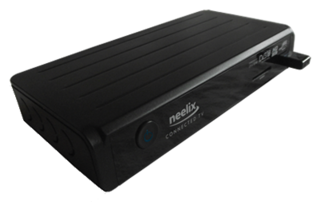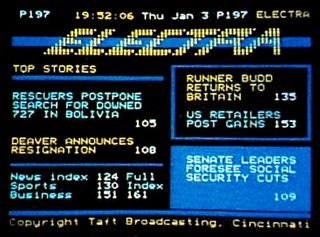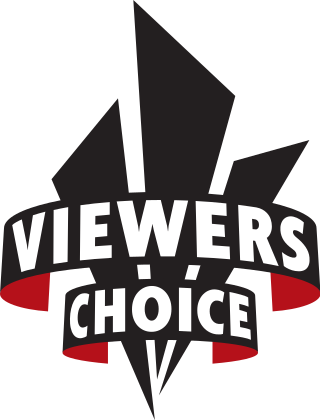
A set-top box (STB), also known as a cable box or receiver and historically television decoder, is an information appliance device that generally contains a TV-tuner input and displays output to a television set and an external source of signal, turning the source signal into content in a form that can then be displayed on the television screen or other display device. They are used in cable television, satellite television, and over-the-air television systems as well as other uses.

Advanced Television Systems Committee (ATSC) standards are an American set of standards for digital television transmission over terrestrial, cable and satellite networks. It is largely a replacement for the analog NTSC standard and, like that standard, is used mostly in the United States, Mexico, Canada, South Korea and Trinidad & Tobago. Several former NTSC users, such as Japan, have not used ATSC during their digital television transition, because they adopted other systems such as ISDB developed by Japan, and DVB developed in Europe, for example.
An integrated receiver/decoder (IRD) is an electronic device used to pick up a radio-frequency signal and convert digital information transmitted in it.
Digital cable is the distribution of cable television using digital data and video compression. The technology was first developed by General Instrument. By 2000, most cable companies offered digital features, eventually replacing their previous analog-based cable by the mid 2010s. During the late 2000s, broadcast television converted to the digital HDTV standard, which was incompatible with existing analog cable systems.

Bell Satellite TV is the division of BCE Inc. that provides satellite television service across Canada. It launched on September 10, 1997. As of April 2017, Bell Satellite TV provides over 700 channels to over 1 million subscribers. Its major competitors include satellite service Shaw Direct, as well as various cable and communications companies across Canada.
Pirate decryption is the decryption, or decoding, of pay TV or pay radio signals without permission from the original broadcaster. The term "pirate" is used in the sense of copyright infringement. The MPAA and other groups which lobby in favour of intellectual property regulations have labelled such decryption as "signal theft" even though there is no direct tangible loss on the part of the original broadcaster, arguing that losing out on a potential chance to profit from a consumer's subscription fees counts as a loss of actual profit.

CableCARD is a special-use PC Card device that allows consumers in the United States to view and record digital cable television channels on digital video recorders, personal computers and television sets on equipment such as a set-top box not provided by a cable television company. The card is usually provided by the local cable operator, typically for a nominal monthly fee.

VideoCipher is a brand name of analog scrambling and de-scrambling equipment for cable and satellite television invented primarily to enforce Television receive-only (TVRO) satellite equipment to only receive TV programming on a subscription basis.

Electra was a teletext service in the United States that was in operation from 1982 up until 1993, when it was shut down due to a lack of funding, and discontinuation of teletext-capable television sets by the only US television manufacturer offering teletext capability at the time, Zenith. It was owned, operated and maintained by Cincinnati-based Taft Broadcasting and Tulsa, Oklahoma-based Satellite Syndicated Systems (SSS), later known as Tempo Enterprises, in cooperation with cable/satellite TV station Superstation WTBS, who carried Electra's data on their vertical blanking interval. SSS's own TV network, the Satellite Program Network, carried the service before it was shut down in 1989. The service was also available to C-band satellite dish users via the Galaxy 1 and Satcom 3R satellites.
Television encryption, often referred to as scrambling, is encryption used to control access to pay television services, usually cable, satellite, or Internet Protocol television (IPTV) services.
Genesis Storytime was a cable TV channel founded in 1983 in Canada by Art Doerksen and Greg Stetski and distributed to several cable TV systems throughout the USA. Its mascot is named Robbie Rainbow.
Subscription television in Australia is provided using technologies such as cable television, satellite television and internet television by a number of companies unified in their provision of a subscription television service. Notable actors in the sector include Foxtel, Netflix and Stan. Regulation of the sector is assured by the Australian Communications and Media Authority.

Dreambox is a series of Linux-powered DVB satellite, terrestrial and cable digital television receivers, produced by German multimedia vendor Dream Multimedia.

Thai TV Global Network (TGN) is a defunct Thai satellite television channel. Тhai TV Global Network is the first and only satellite TV broadcasting center in Thailand. TGN, under the operation of the Royal Thai Army Radio and Television Channel 5, provides 24-hour-programs broadcasting to 170 countries on five continents. All facets of Thai life, culture, activities, information, news and entertainment are included in the programming for the channel.
The DBox is a DVB satellite and cable digital television integrated receiver decoder. They were distributed widely for use with Pay television channels. It was commissioned by the Kirch group's DF1, an early German provider of digital television that later merged with Premiere. The hardware was developed and produced by Nokia though later also produced by Philips and Sagem under license.

Satellite television is a service that delivers television programming to viewers by relaying it from a communications satellite orbiting the Earth directly to the viewer's location. The signals are received via an outdoor parabolic antenna commonly referred to as a satellite dish and a low-noise block downconverter.

A digital television adapter (DTA), commonly known as a converter box or decoder box, is a television tuner that receives a digital television (DTV) transmission, and converts the digital signal into an analog signal that can be received and displayed on an analog television set. Some also have an HDMI output since some TVs with HDMI do not have a digital tuner. The input digital signal may be over-the-air terrestrial television signals received by a television antenna, or signals from a digital cable system. It normally does not refer to satellite TV, which has always required a set-top box either to operate the big satellite dish, or to be the integrated receiver/decoder (IRD) in the case of direct-broadcast satellites (DBS).

Viewers Choice was a Canadian English language pay-per-view (PPV) and near video on demand service. It was owned by Viewers Choice Canada Inc., which at the time of its closure was majority-owned and managed by Bell Media, with minority partners Rogers Media and ESPN Inc., and had been carried by various cable and IPTV service providers, primarily in Eastern Canada.

Currently, there are two primary satellite television providers of subscription based service available to United States consumers: DirecTV and Dish Network, which have 21 and 10 million subscribers respectively.
UPI Newstime was a cable television network founded by United Press International in 1978, and premiering July 3 of that year. UPI Newstime was the second 24-hour all-news television network in the US for cable TV, following AP Newscable for 13 years and predating CNN by 2 years. UPI Newstime was unique in how it distributed its programming to local cable TV (CATV) headends via satellite, using a form of slow-scan television, or SSTV technology. Using SSTV reduced satellite transmission costs for UPI and was suitable at the time for the programming produced by UPI for the channel, which mainly relied on still slides and wirephotos acquired by UPI's own newsgathering operations.











